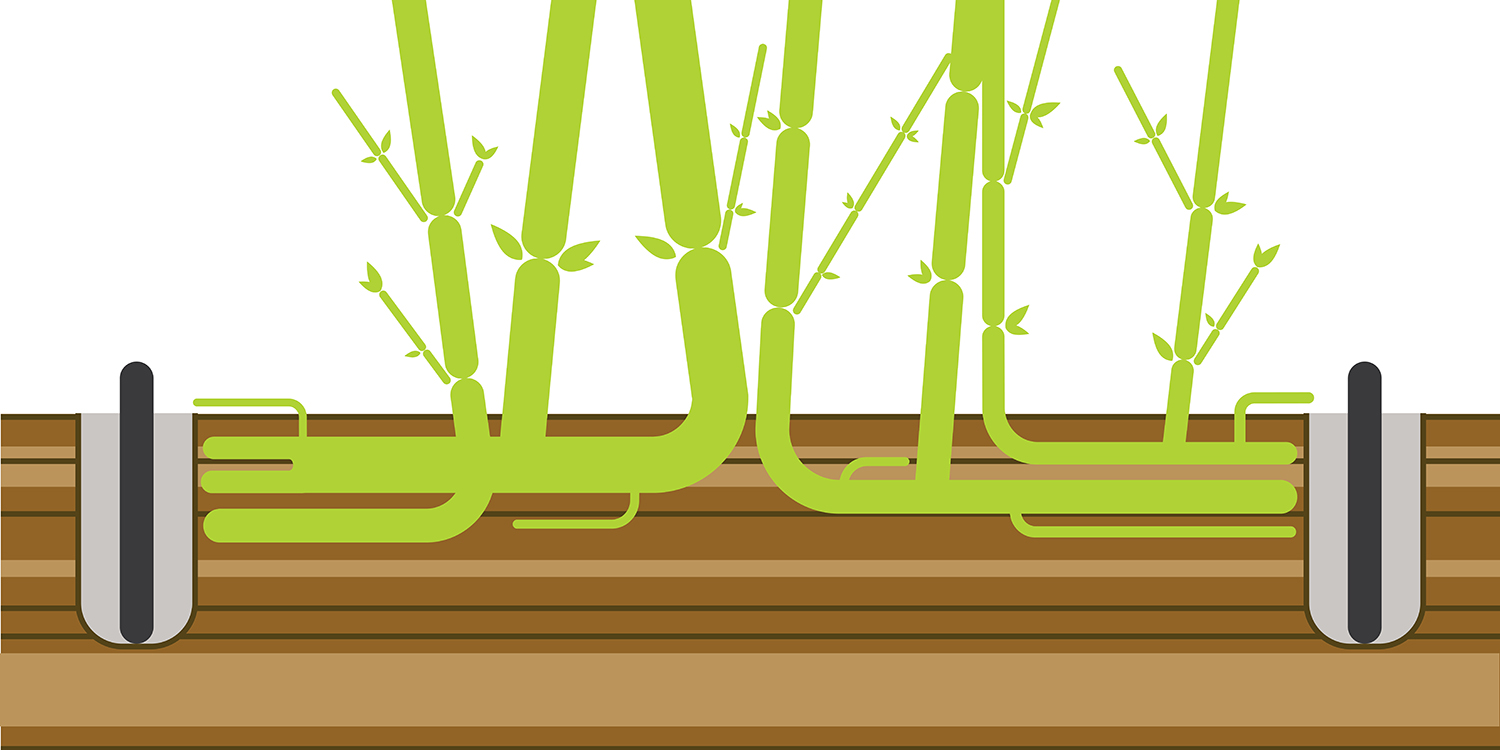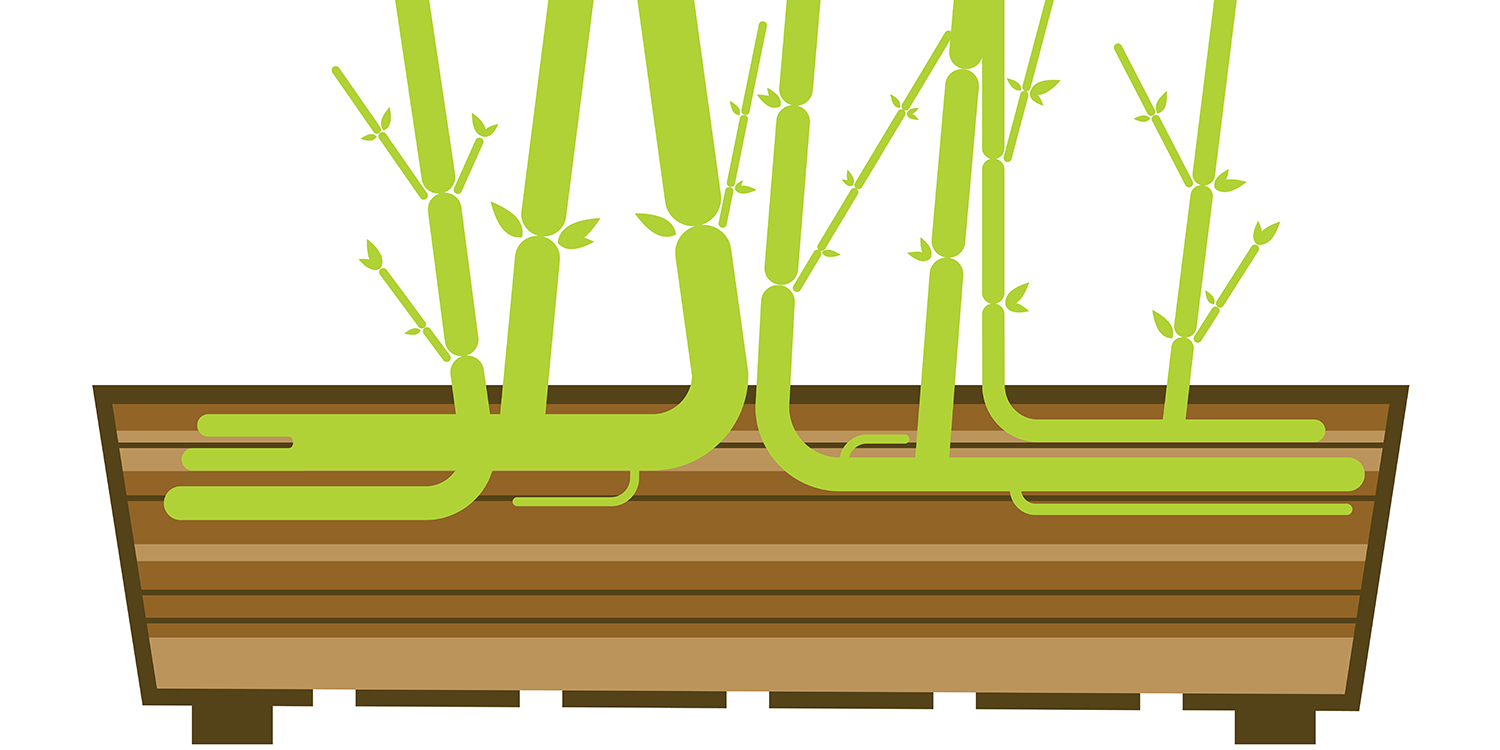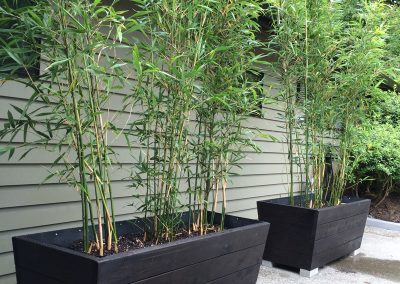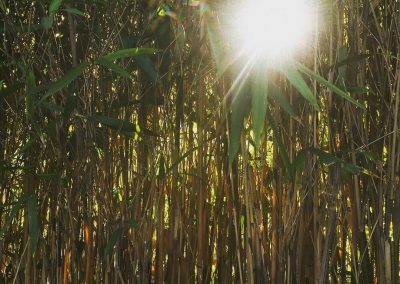Bamboo Services
What is Bamboo?
Bamboo is the largest species of grass. As a grass, bamboo has a shallower root structure than other plants that grow to the same height, such as trees. Bamboo roots typically only descend up to two feet vertically underground, but they can run horizontally in any direction as far as the plant is tall. The stalk, or culm, of the bamboo continues underground into a rhizome, from which these runner roots grow. These runners are all connected underground to the main mother plant. Bamboo rhizomes shoot up full diameter culms; these culms harden as the plant matures. Branches extend from the nodes of the culms and leaf out as the plant reaches its mature height.
Bamboo is the fastest growing plant. There are two main types of bamboo, running bamboo and clumping bamboo. Some species of running bamboo can spread 5 feet or more per year, whereas most species of clumping bamboo only spread up to 5 inches per year. Clumping bamboos have short root structures and will generally form circular clumps. Running bamboos spread through the growth of long, horizontal roots with the ability to travel far distances horizontally from the mother plant.
In general, bamboo grows up in the spring and out in the summer and fall. New shoots typically emerge late March through June with the culms increasing in diameter and height each shooting season. Once the bamboo has finished shooting, the plant will begin to spread underground focusing on rhizome development through the late summer and early fall in preparation for the subsequent spring.
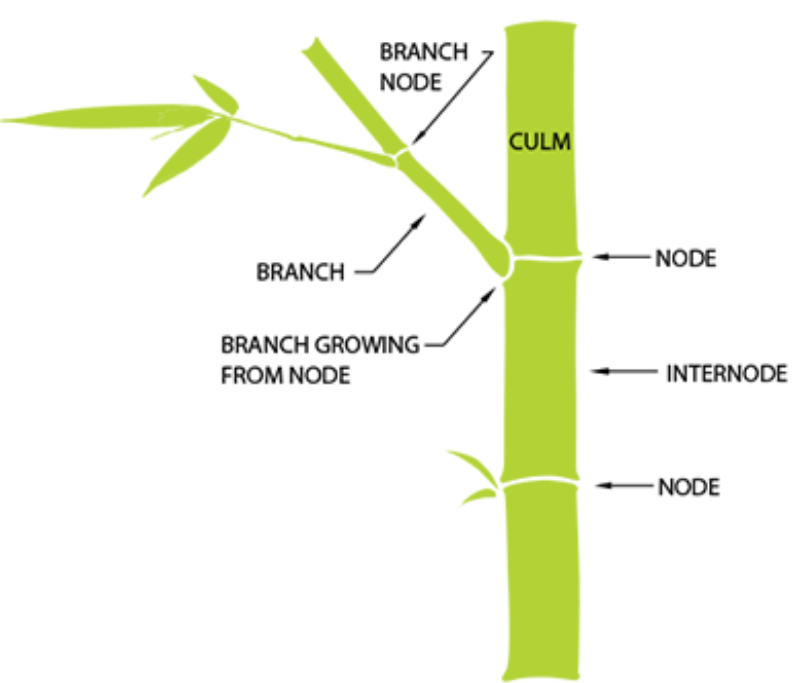
Removal
Bamboo removal is an extremely labor-intensive process best left to trained professionals. Due to the underground rhizome structure, chemicals or fire will do little to slow the plant down. When we perform removal, we follow the running roots, called rhizomes, to their terminus away from the mother plant. Though the process is daunting, it is achievable with experienced assistance. We have a track record of proven success when it comes to bamboo removal.
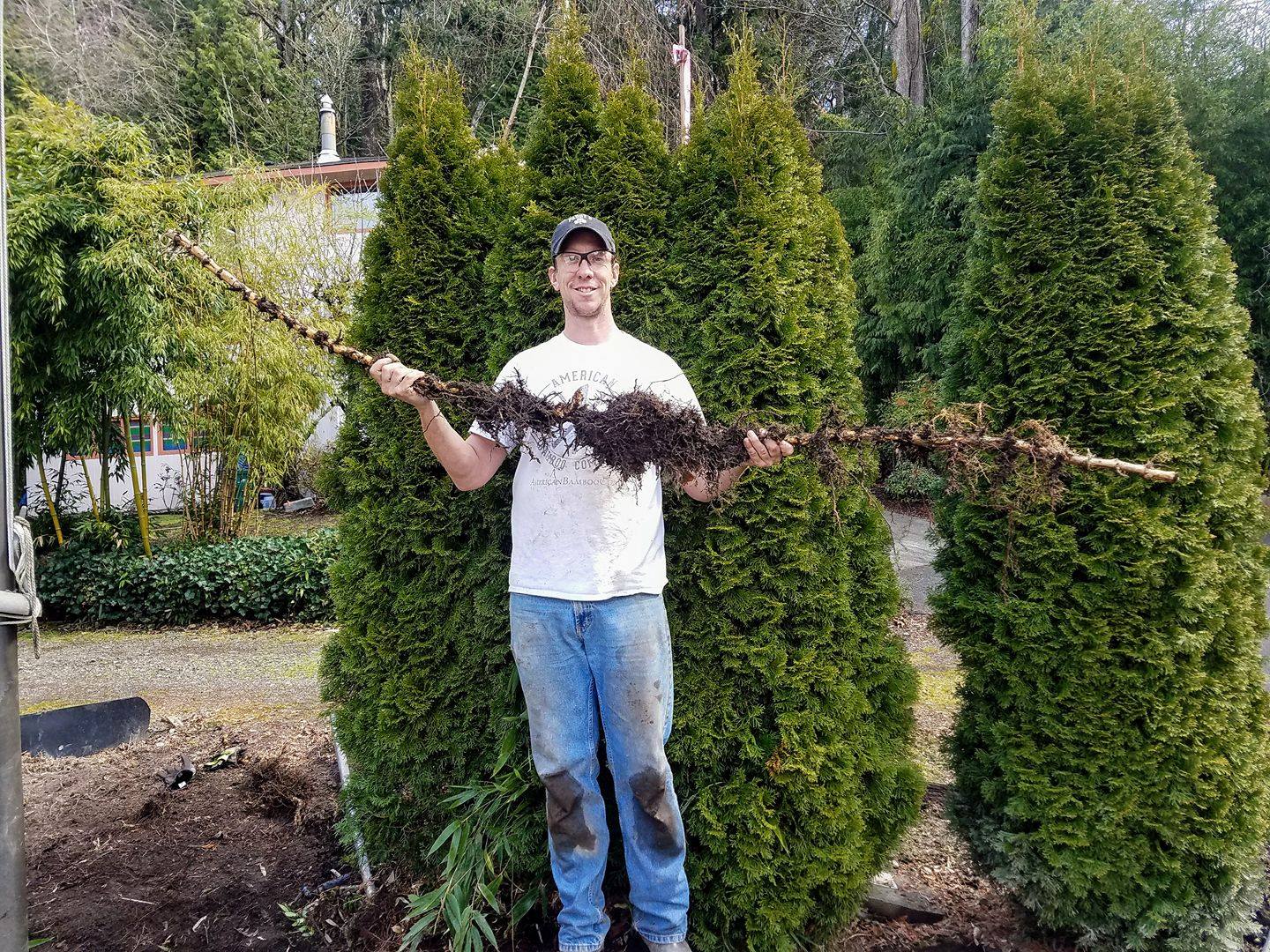
Typical removal jobs require hand tools such as axes, shovels, pickaxes, and pry bars. Heavier removal equipment includes a slam bar, a sharp spade with a heavy metal bar in the hollow shaft that can be slammed down to perform a cut of the bamboo roots. For the toughest jobs, a stump grinder is used.
A standard removal day for us lasts 5-6 hours, as we are often scheduled to perform bamboo removal up to five days a week for several months. The removal process requires a variety of labor-intensive physical tasks including moving and using heavy machinery, breaking concrete, hauling rocks, extracting fence posts, digging trenches, and of course removing bamboo rhizomes and root balls, which often weigh upwards of 100 pounds.
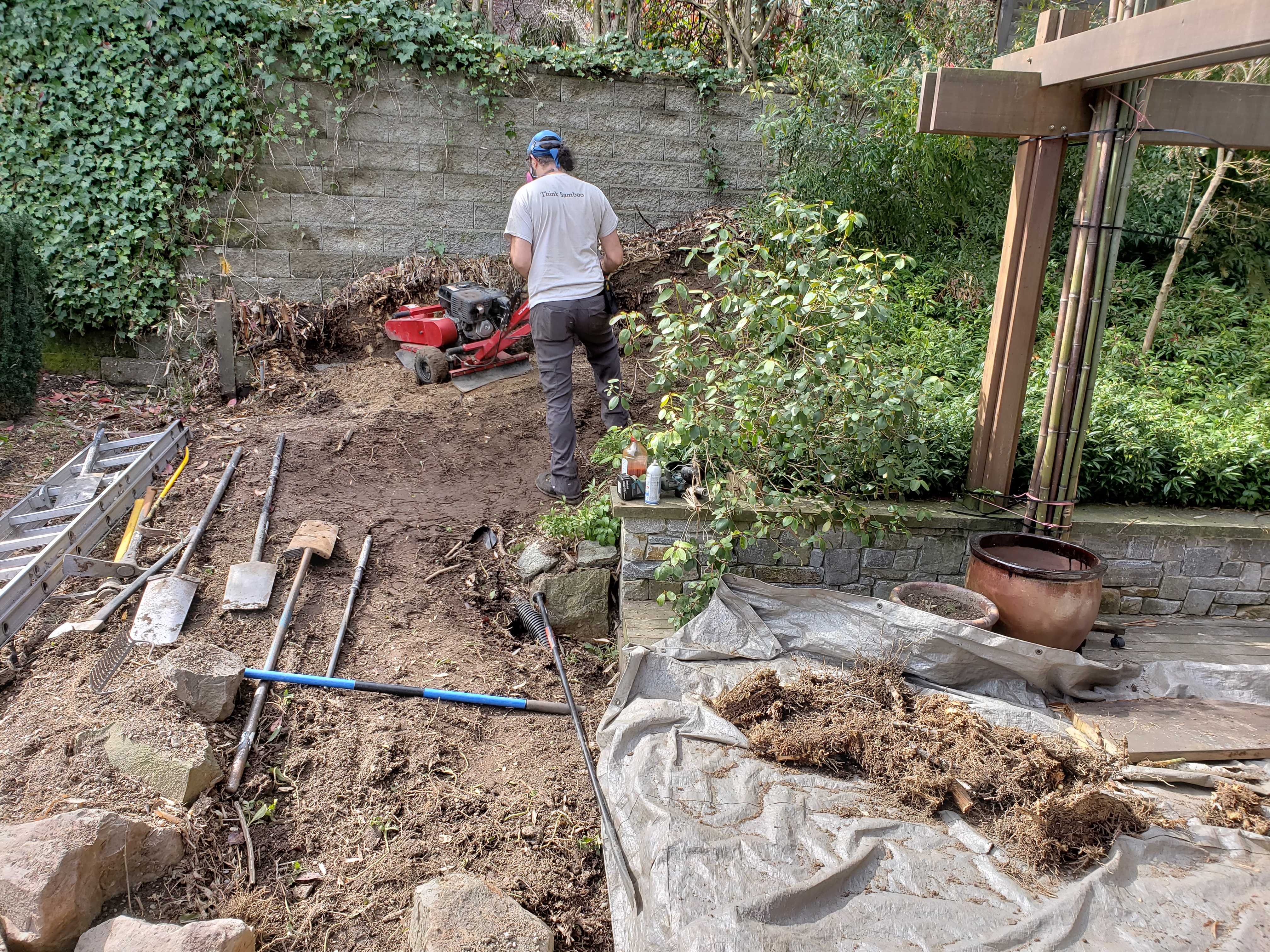
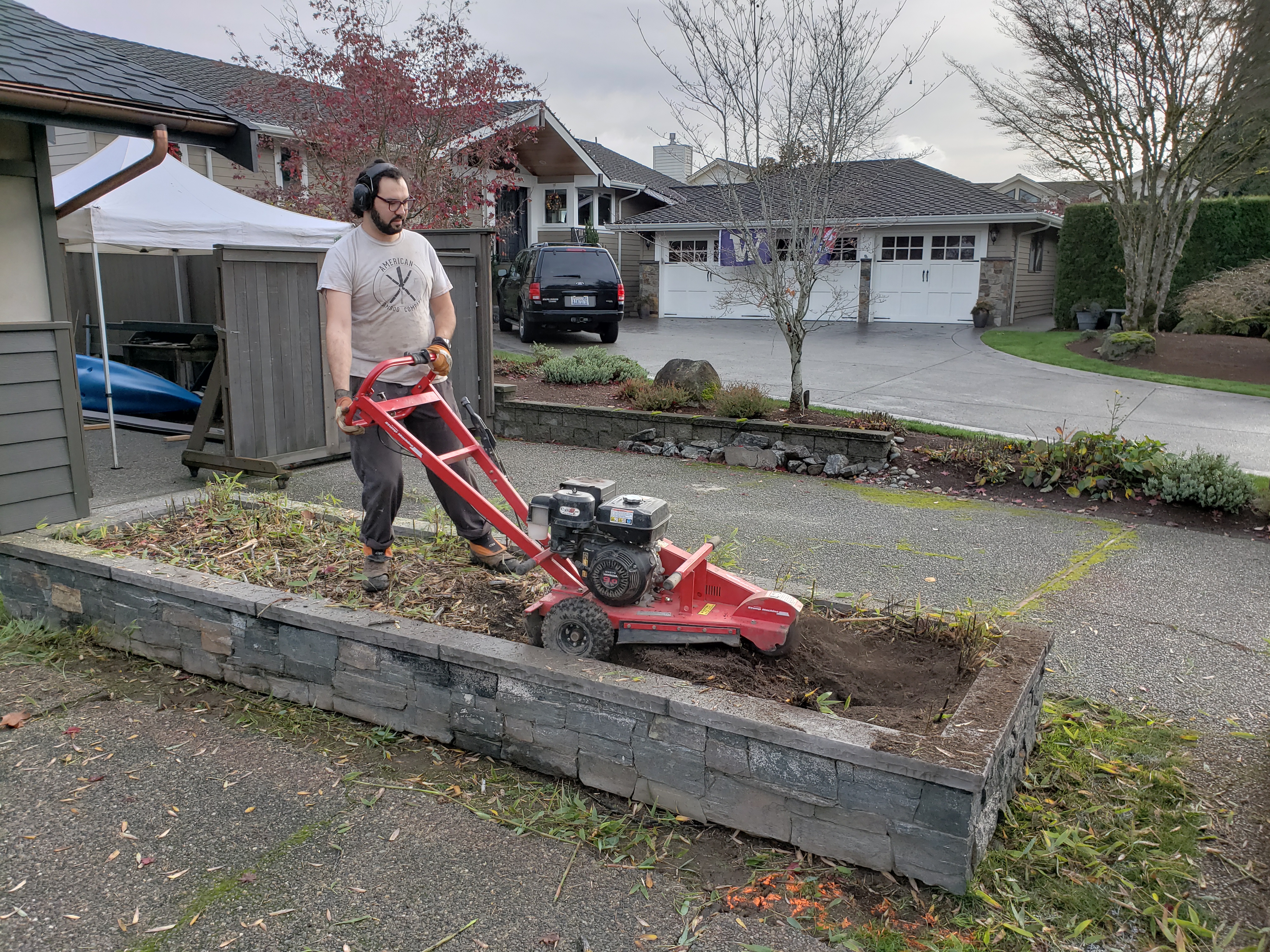

Rhizomes can grow under and around fences, decks, pipes, foundations, and other architectural elements. Our team is trained to deal with the formidable odds that bamboo presents, and we have many years of experience eradicating bamboo from properties around the region.
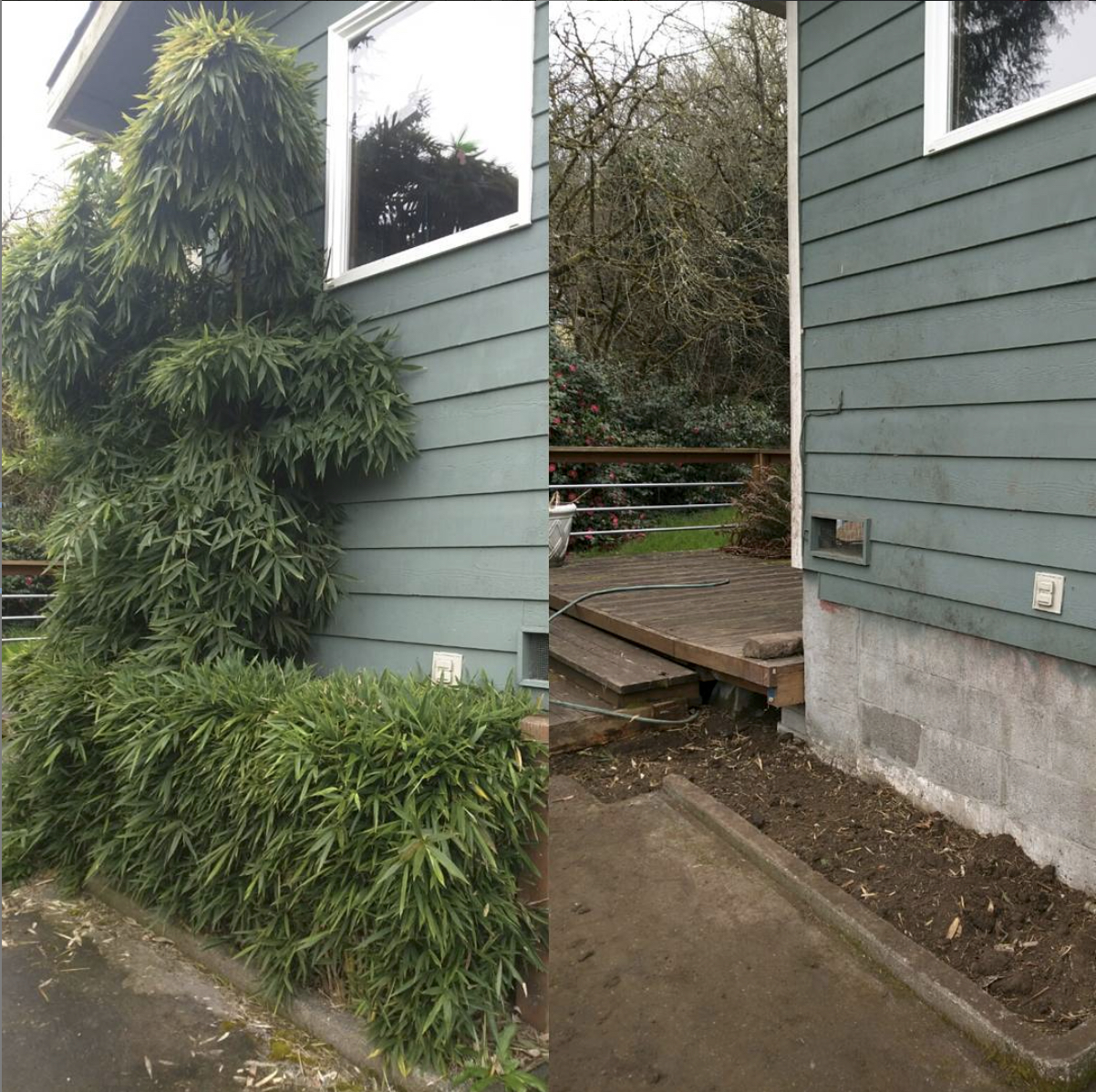
Bamboo removal is a messy process, frequently generating truck and trailer loads full of bio-waste, including shoots, rhizomes, root balls, and branches. We prioritize our customer service and remove all bio-waste generated from our removal jobs as part of the contract. We make multiple green waste runs during the removal process and always sweep, rake, and blow clean our work areas after completing the job. For tougher jobs where a stump grinder is used, the removal process provides the added benefit of aerating the soil in your yard, which makes for great replanting conditions.
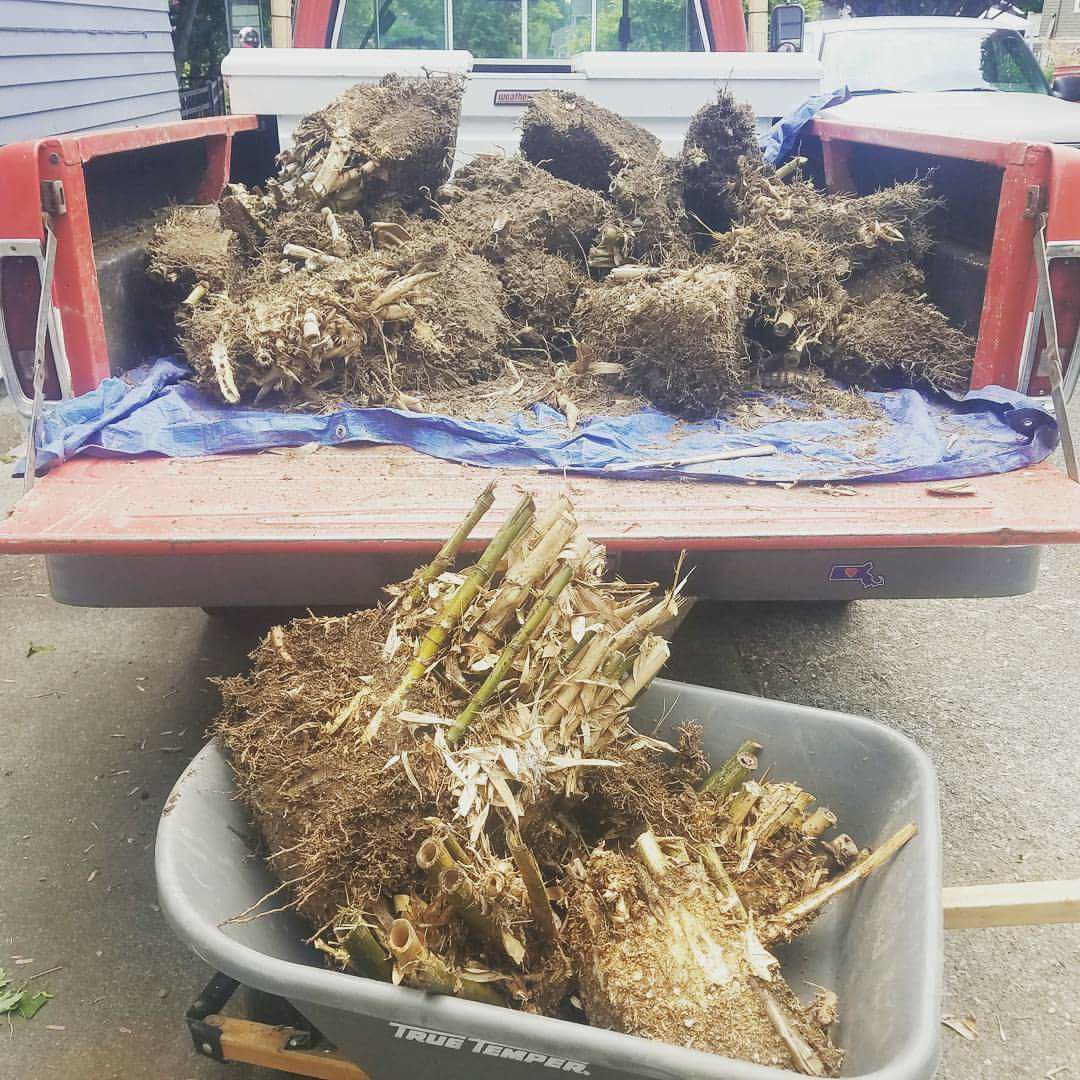
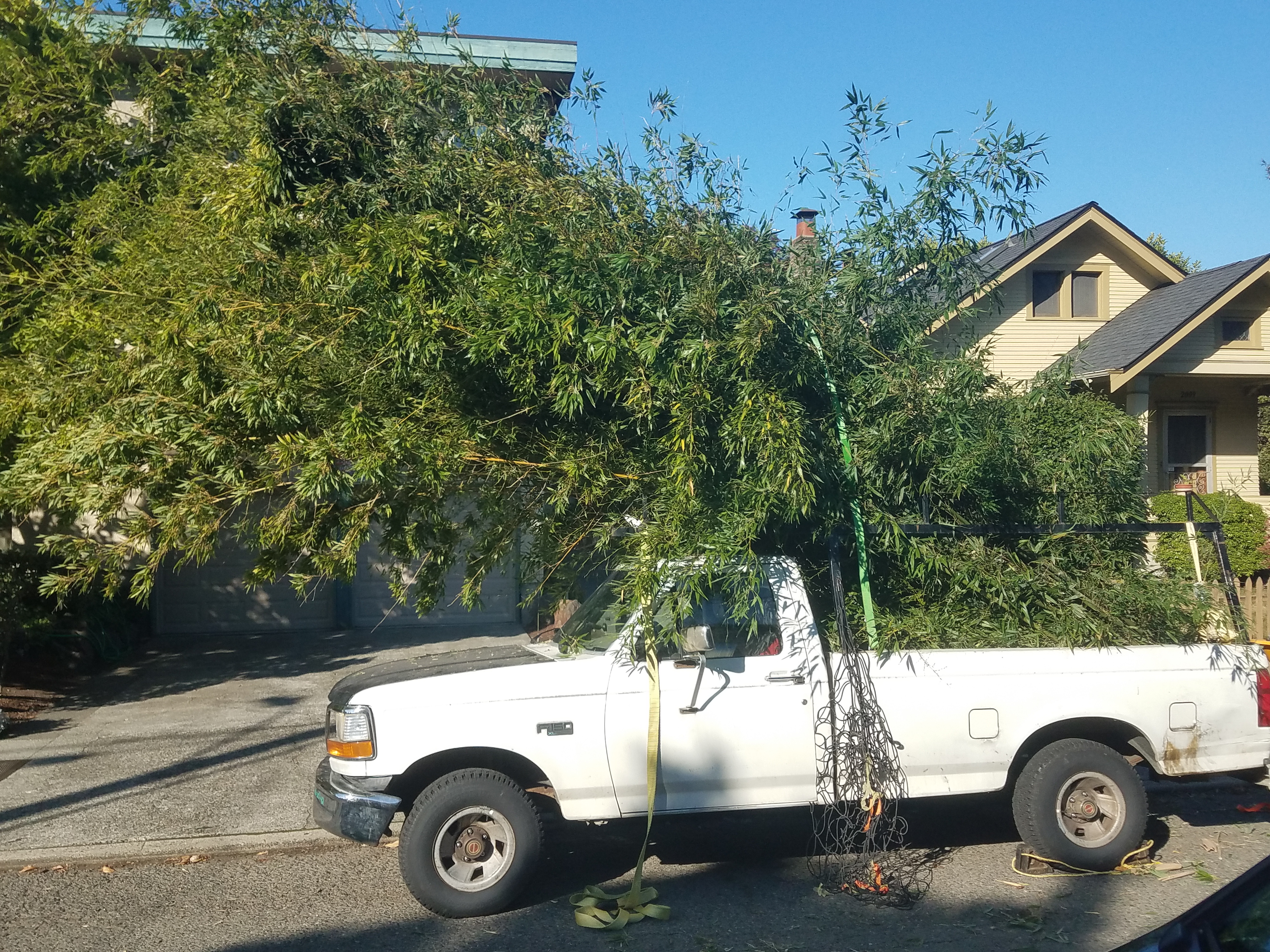
Containment
The common bamboo planting methods we recommend are barrier containment, trenching, container planters, and mound planters. We frequently recommend a c-barrier containment method that combines both barrier containment and trenching. Each method requires different levels of maintenance and are explained individually in detail below.
When you want to keep your bamboo without performing yearly root maintenance, installation of a rhizome root barrier is an excellent option. Many people make ill-advised attempts at using metal, wood, or concrete to slow down the underground roots; all of these decompose over time. The concrete will crack, and the bamboo will find a way out.
The best option is High-Density Polyethylene Plastic, or HDPE. This comes in 40,60, and 80 millimeter thicknesses. As we have seen the lower thicknesses fail in the past, we always suggest going with the 80 mm thickness. HDPE, as a root barrier, also comes in 24” or 30” depths. The difference in cost in negligible, so we suggest going with the higher level 30” deep barrier. Barrier containment involves digging a 28” deep by 12” wide trench where a 30” tall 80 mm HDPE rhizome barrier is installed. The barrier creates an underground enclosure leaving approximately 2” above ground to force rhizomes to try and jump the barrier.
Once or twice a year you should check the barrier for jumping rhizomes and prune any you see. This keeps the mother plant happy and prevents rhizomes from randomly roaming your property. For aggressive, fast runners or smaller planting areas, a barrier containment might not be recommended as the plant would be at higher risk of becoming root bound at a quicker rate.
Trenching involves digging a 12” deep by 12” wide trench around the bamboo planting area.
The trench can be left empty or filled with sand. A few times a year you should check the trench and prune any rhizomes. Trenches can also be added to existing bamboo groves to prevent spreading.
Our most frequently recommended containment method is the c-barrier. The c-barrier consists of HDPE barrier on three sides and a sand trench on the remaining fourth side. This containment method is particularly beneficial for fast running bamboos as well as smaller planting areas.
The sand trench allows the bamboo rhizomes a place to escape preventing the plant from becoming root bound thus making this containment method a longer-term option than just barrier alone. A few times a year you should check the trench and prune any rhizomes to prevent the plant from spreading.
The mound planter involves making a soil mound of 18″-24″ tall and 3’ -4’ wide within all directions for each bamboo plant. This will give each bamboo plant plenty of space to grow into. Over time the mound will compact to about 12″ tall which is not a problem for bamboo.
The mound’s slight elevation over the surrounding ground will slow rhizome growth because rhizomes do not like to run downhill. Additionally, the mound will make it easier to see rhizomes and prune those running away from the mother.
Bamboo can be planted in any container that is at least 36” wide and 24” tall. Container planting is a great way to ensure that your bamboo is sufficiently enclosed. Containers come in all shapes, sizes, and styles to fit your needs; you can also rest assured that bamboo will not grow outside of a well-maintained container.
Bamboo grows well in containers if planted in good soil with a high nitrogen content. It is also good to fertilize container bamboo at least once a year. However, containers do restrict space for rhizomes and reduce overall plant height by approximately 20% when compared to bamboo planted in soil.
When selecting a container, make sure to size it appropriately. Larger types of bamboo will need larger containers. In general, bamboo prefers larger containers to grow best. Make sure to use rich, well-draining soil.
The container will keep the bamboo rhizomes from running. The bamboo will require more frequent watering and care as it has less soil available than if it was planted in the ground.
After some period of time (typically 2-5 years) the bamboo will become root bound in the container. At this point, it can be divided, up-potted, or trimmed and returned to the same container.
Installation
Many people enjoy the beauty, privacy, tranquility, and various other benefits a bamboo grove provides. In these cases, containment methods (as listed above) and maintenance are an appealing and achievable strategy for preventing the unwanted spread of the plant. With proper planting, recommended maintenance, and professional assistance, bamboo can be enjoyed without worry.
Why Bamboo?
With its beautiful evergreen foliage, bamboo is one of the most attractive plants to use for a hedge. Since it is one of the fastest growing plants, bamboo is an excellent option for creating a privacy screen. Its short growth cycle allows for the plant to reach its mature height in a mere 3-5 years. Bamboo is a hardy and resistant plant that is tolerant of many environments.
Planting bamboo is one of the best ways to help our environment and reduce your carbon footprint. Bamboo has a high carbon dioxide exchange rate, releasing 35% more oxygen than an equivalent stand of trees. Bamboo is also a great soil conservation tool, reducing erosion due to its extensive underground, interconnected rhizome structure.
Maintenance
Regardless of how your bamboo is planted, the simplest way to control growth is with proper maintenance. To ensure bamboo only grows where you want it to, you should prune rhizomes no less than twice a year and prune the bamboo root ball whenever the plant appears rootbound.
Each spring and fall your bamboo will send out rhizomes in all directions. Rhizomes growing in unwanted directions should be cut and removed to prevent spreading. Our favorite tool for rhizome pruning is the Bamboo Spade, which can be purchased here. We use this same tool on a daily basis because it is designed specifically for bamboo and greatly simplifies cutting rhizomes.
In time bamboo will outgrow its container and become rootbound. When this happens you should prune the root ball. To prune root balls we use the bamboo spade in conjunction with saws to cut each root ball to a manageable size. Then we normally compost all root balls, but you can easily plant your new root ball or give it to a friend.
American Bamboo Company has the knowledge and experience to help with any and all bamboo maintenance needs. We offer maintenance services including but not limited to sand trench maintenance, pruning and trimming of bamboo, thinning of groves, barrier maintenance, custom built and installed irrigation systems, bamboo plant support installations, and we also offer consultation services to help assess how to best support and maintain your beautiful bamboo.

